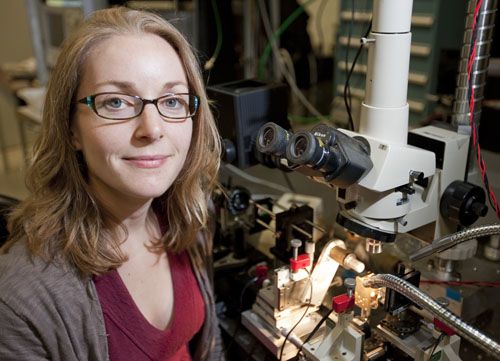Lab finds crystal clear way to better biodection
 (Download Image)
Sarah Baker sits by the microscope used to observe biorganisms detected by the photonic crystal sensor. Jacqueline McBride/LLNL
(Download Image)
Sarah Baker sits by the microscope used to observe biorganisms detected by the photonic crystal sensor. Jacqueline McBride/LLNL
In a boost for public health monitoring and biosecurity, Laboratory scientists have developed a flow-through, silicon-based photonic crystal that can detect low numbers of nanometer-scale viruses in real time.
The compact, seven-micron long (one-tenth the size of a human hair) crystal is made of virus-sized air holes etched in a silicon slab and connected to two waveguides. The researchers estimate through computer simulations and experiments that the sensor can detect less than five virus particles, which is on par with the state-of-the art detection devices.
The photonic crystal sensor has additional advantages. Standard techniques for biodetection, such as cell culture and polymerase chain reaction, are labor-intensive and time-consuming. But the photonic crystal method allows for detection that is label-free, affording real-time measurements without extensive sample preparation.
"We explored the photonic crystal sensor for virus detection because it might offer a number of advantages over other methods," said LLNL chemist Sarah Baker, and lead author of a cover article in the Sept. 13 issue of the journal, Applied Physics Letters. "The photonic crystal proved to be highly sensitive and might be used to detect low numbers of viruses and bacteria in real time, without any sample preparation. The silicon-based sensor geometry also allows the integration with microfluidics and other electronic and photonic signal transduction methods on a single chip."
Not only is the crystal well-suited for field detection of biological particles, but the sensor geometry enables physical trapping of particles, enhancing the probability of capture and detection.
"An additional advantage is that the diameter of the pores can be tuned to infiltrate particles of a desired size," Baker said. "The device can be designed to detect a target virus particle of specific size and exclude the signal from larger particles like dust and bacteria."
To test the method, Baker and colleagues exposed the crystals to polystyrene beads, which are accurate models of virus particles, when the appropriate particle size, morphology, and optical properties are selected. 260-nanometer and 320-nanometer beads were placed on the surface of the photonic crystal chip. The 260-nm beads were small enough to infiltrate the crystal's pores and were detected, but the 320-nm beads were too large, and did not impact the sensor readout.
Other Livermore authors include Michael Pocha, Allan Chang, Donald Sirbuly, Tiziana Bond and Sonia Létant. Sabrina Fletcher (TID) designed the cover illustration.
The work was completed in conjunction with Stefano Cabrini of the Molecular Foundry at Lawrence Berkeley National Laboratory.
The work was funded by the Laboratory Directed Research and Development program.




